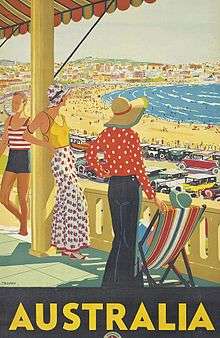Australian National Travel Association
The Australian National Travel Association (1929–2001) was a semi-government industry organisation which promoted tourism and travel in Australia.
Establishment
The Australian National Travel Association was formed in 1929 at the onset of the Great Depression by Sir Charles Lloyd Jones (1878-1958), merchant and patron of the arts (who became director of its board of management). Most states had already, or soon had, tourist bureaux though their budgets were insufficient. Prime Minister Stanley Bruce announced the formation of the national organisation on Wednesday 1 May 1929,[1] allocating £100,000, obtained mostly from tourist industries for Australian overseas publicity.
Operation

The organisation was put under the control of a committee of representatives of the principal contributing bodies, comprising Harold W. Clapp, chairman of Victorian Railway Commissioners, D. I. Dowell, representing British and foreign shipping interests, C. W. Wilson, proprietor of Scott's Hotel, Melbourne, on behalf of Australian hotels, and C. Lloyd Jones, of David Jones Ltd., Sydney, for Australia's general business interests. In addition representatives were appointed to England and America,[2] to 'make vigorous contact with travel-selling agencies through the English-speaking world'.[3] H. C. Fenton became representative in Great Britain in Grand Buildings, Trafalgar Square, London, and the association's representative in U.S.A. and Canada A.H. O'Connor worked from an office in the Adam Grant Building at 114 Sansom Street, San Francisco.[4]
In 1956 the first managing director of the Australian National Travel Association, Charles Holmes, appointed West Australian award-winning journalist Basil Atkinson to reopen the first ANTA office abroad since the war, in San Francisco, to promote Australia as a tourist destination for Americans. After a successful advertising campaign, Atkinson was recalled to be general manager of ANTA, reorganising operations and winning increased government financial support which supported the opening of an office in London, followed by offices in Wellington and New York. In order to allay perceptions of competition between the states and the national organisation Atkinson arranged for all states and two government agencies to have representation on the ANTA board.[5]
Marketing
From its inception the Association marketed creatively, first commissioning posters featuring striking images and simple slogans from Australia’s leading poster designers (some now iconic, like Trompf’s Bondi Beach) including Percy Trompf, James Northfield[6] and Gert Sellheim to attract international tourists largely ignorant of Australia.[7]
Subsequently, in 1934, ANTA established a monthly travel magazine Walkabout which continued publication until 1974. It attracted widespread advertising support from tourism businesses and promoted aspects of Australia of which even its own citizens would have been unaware.
Reorganisation
An investigation of tourism was commissioned from the American firm Harris, Kerr, Forster by ANTA Managing Director Basil Atkinson.[8] Their 345-page report, entitled Australia's Travel and Tourist Industry 1965 and known colloquially as the `HKF Report' was presented to the ANTA in September 1965. This was the first comprehensive survey of the travel and tourism industry to be carried out in Australia.[9] On its recommendations federal parliament passed the Australian Tourist Commission Act, resulting in the Association's major function, tourism marketing, being incorporated into a statutory authority, the Australian Tourist Commission (ATC) which provided for the promotional functions of ANTA to be taken over from July 1967, with Atkinson being appointed its first chief executive.[10]
ANTA maintained its representation of tourism stakeholders and became the Australian Tourism Industry Association in 1985, prompted by its growing industry potential, and then was renamed the Tourism Council Australia in 1995.[11] However, in early 2001 it was placed in receivership, to be replaced the Tourism Task Force, established under the Hawke Labor government in the 1980s, and the Australian Tourist Commission.[12]
References
- ↑ OVERSEAS PUBLICITY (1929, May 1). News (Adelaide, SA : 1923 - 1954), , p. 4 (HOME EDITION). Retrieved July 24, 2016, from http://nla.gov.au/nla.news-article129139634
- ↑ AUSTRALIAN NATIONAL TRAVEL ASSOCIATION. (1929, September 13). Daily Standard (Brisbane, Qld. : 1912 - 1936), , p. 2. Retrieved July 24, 2016, from http://nla.gov.au/nla.news-article187397485
- ↑ Waitt, G. (1997). Selling paradise and adventure: Representations of landscape in the tourist advertising. Australian Geographical Studies, 35(1), 47-60.
- ↑ AUSTRALIAN NATIONAL TRAVEL ASSOCIATION. (1930, December 3). The Daily News (Perth, WA : 1882 - 1950), , p. 1 (HOME (FINAL) EDITION). Retrieved July 24, 2016, from http://nla.gov.au/nla.news-article83823199
- ↑ Beresford, Don (2013) Obituary 'Basil Atkinson, 1924-2013: Tourism chief put Australia on the map' Sydney Morning Herald March 9, 2013
- ↑ Northfield, James & Hetherington, Michelle, 1959- & National Library of Australia & Northfield, James, 1887-1973 (2006). James Northfield and the art of selling Australia. National Library of Australia, Canberra, A.C.T
- ↑ Spearritt, Peter (1991) 'Sites and Sights: Australian Travel Posters 1909-1990' in Trading Places: Australian Travel Posters 1909-1990, Monash University Gallery and National Centre for Australian Studies: Victoria
- ↑ Leiper, N. (1979). The framework of tourism: Towards a definition of tourism, tourist, and the tourist industry. Annals of tourism research, 6(4), 390-407.
- ↑ Lloyd, Pamela (1997) Twenty Years of Talking: A history of the meetings industry in Australia. Meetings Industry Association of Australia, Neutral Bay, Australia, p.10
- ↑ Canberra Times (ACT : 1926 - 1995), Thursday 27 October 1966, page 1
- ↑ Craik, Jennifer (2001) Tourism, Culture and National Identity. In Bennett, Tony & Carter, David John, 1954- (2001). Culture in Australia : policies, publics and programs. Cambridge University Press, Cambridge ; Melbourne
- ↑ Wells, Josette Marie (2010) ’One voice for Australia' : a marketing history of Australia's National Tourist Organisation 1929-1967. Monash University thesis http://arrow.monash.edu.au/hdl/1959.1/896648